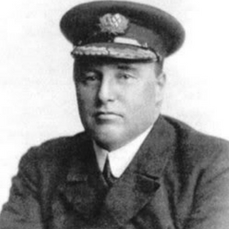03 September 2017
CWGC marks Merchant Navy Day
Since 2000, the men and women of the Merchant Navy who gave their lives to preserve the life of the nation during the two world wars have been honoured on 3 September. Today, the Red Ensign – the UK Merchant Navy’s official flag - will be flown above buildings across the UK in memory of those lost. Meanwhile, the annual Merchant Navy Day service will take place at the CWGC Tower Hill Memorial, which commemorates more than 35,000 men and women of the Merchant Navy and Fishing Fleets.

The Merchant Navy at war
In the First World War, the civilian navy's duty was to be the supply service of the Royal Navy, to transport troops and supplies to the armies, to transport raw materials to overseas munitions factories and munitions from those factories, to maintain, on a reduced scale, the ordinary import and export trade, to supply food to the home country and - in spite of greatly enlarged risks and responsibilities - to provide both personnel and ships to supplement the existing resources of the Royal Navy.
Losses of men and vessels were high from the outset, as British waters were strewn with enemy mines. However, they had peaked in 1917 when in January the German government announced the adoption of "unrestricted submarine warfare". The subsequent preventative measures introduced by the Ministry of Shipping - including the setting up of the convoy system where warships were used to escort merchant vessels - led to a decrease in losses but by the end of the war, 3,305 merchant ships had been lost and more than 17,000 lives.

SS Chyebassa, a merchant ship of the British India Line, 1917 © IWM (Q 94607)
In the Second World War, losses were again considerable in the early years, reaching a peak in 1942. The heaviest losses were suffered in the Atlantic, but convoys making their way to Russia around the North Cape, and those supplying Malta in the Mediterranean were also particularly vulnerable to attack. In all, 4,786 merchant ships were lost with nearly 32,000 lives.
The memorial
Tower Hill Memorial stands on the south side of the garden of Trinity Square, London.
The 1914-18 monument consists of a vaulted corridor 21.5 metres long, seven metres wide and seven to 10 metres high, open at either end. It has three wide openings at front and back in which are placed pairs of columns and is surmounted by a solid pediment bearing the dedicatory inscription.
The names are inscribed on bronze panels covering the eight main masonry piers which support the roof. No rank or rating other than Master or Skipper is indicated.

The monument, designed by Sir Edwin Lutyens with sculpture by Sir William Reid-Dick, was begun in 1927 and unveiled by Her Majesty Queen Mary on 12 December 1928. It commemorates more than 11,900 names and bears the inscription:
1914-1918
TO THE GLORY OF GOD AND THE HONOUR OF
TWELVE THOUSAND OF THE MERHCANT NAVY AND FISHING FLEETS
WHO HAVE NO GRAVE BUT THE SEA
When the question arose of commemorating the men of the Merchant Navy who lost their lives during the Second World War and have no known grave, it was agreed the new memorial should be combined with the existing monument.
The architect, Sir Edward Maufe, designed a semi-circular sunken garden adjoining the 1914-18 memorial.
From the 1914-18 Memorial, stone steps flanked by high stone pylons, on which are the Merchant Navy badges and wreaths, lead down to the sunken garden. Between the flight of steps is the main dedicatory inscription:
1939-45
THE TWENTY-FOUR THOUSAND OF THE MERCHANT NAVY AND FISHING FLEETS
WHOSE NAMES ARE HONOURED ON THE WALLS OF THE GARDEN
GAVE THEIR LIVES FOR THEIR COUNTRY
AND HAVE NO GRAVE BUT THE SEA
The inscription is guarded by sculptured figures in stone representing an office and a seaman of the Merchant Service. The internal face of the semi-circular wall surrounding the garden is cased in bronze, which bears the names of almost 24,000 casualties. At regular intervals round this bronze casing are seven stone sculptured allegorical figures representing the Seven Seas. All the sculpture is by Sir Charles Wheeler.
The Second World War extension, was unveiled by Her Majesty Queen Elizabeth II on 5 November 1955.

Archibald Bisset Smith, V.C., is one of the casualties commemorated on the memorial.
Rank:Master, (Lieut. R.N.R.)
Unit : S.S. "Otaki" (Plymouth), Mercantile Marine
Date of death: 10 March 1917
Age: 38

He received his award for his action as Master of the SS Otaki, a ship of the Mercantile Marine. On 10 March 1917 in the Atlantic, the SS Otaki, whose armament consisted of one 4.7-inch gun, sighted the German raider SMS Moewe, which was armed with four 5.9-inch, one 4.1-inch and two 22-pounder guns. The raider called on Otaki to stop, but Captain Smith refused to do so. A duel ensued, during which Otaki secured a number of hits and caused considerable damage, but she herself sustained much damage and was on fire. Captain Smith ordered his crew to abandon ship, but he stayed on board and went down with his ship.
As a Merchant seaman he could not receive the VC at that time. In 1919, he was posthumously promoted a Temporary Lieutenant in the Royal Naval Reserve and was then entitled to receive the VC.

